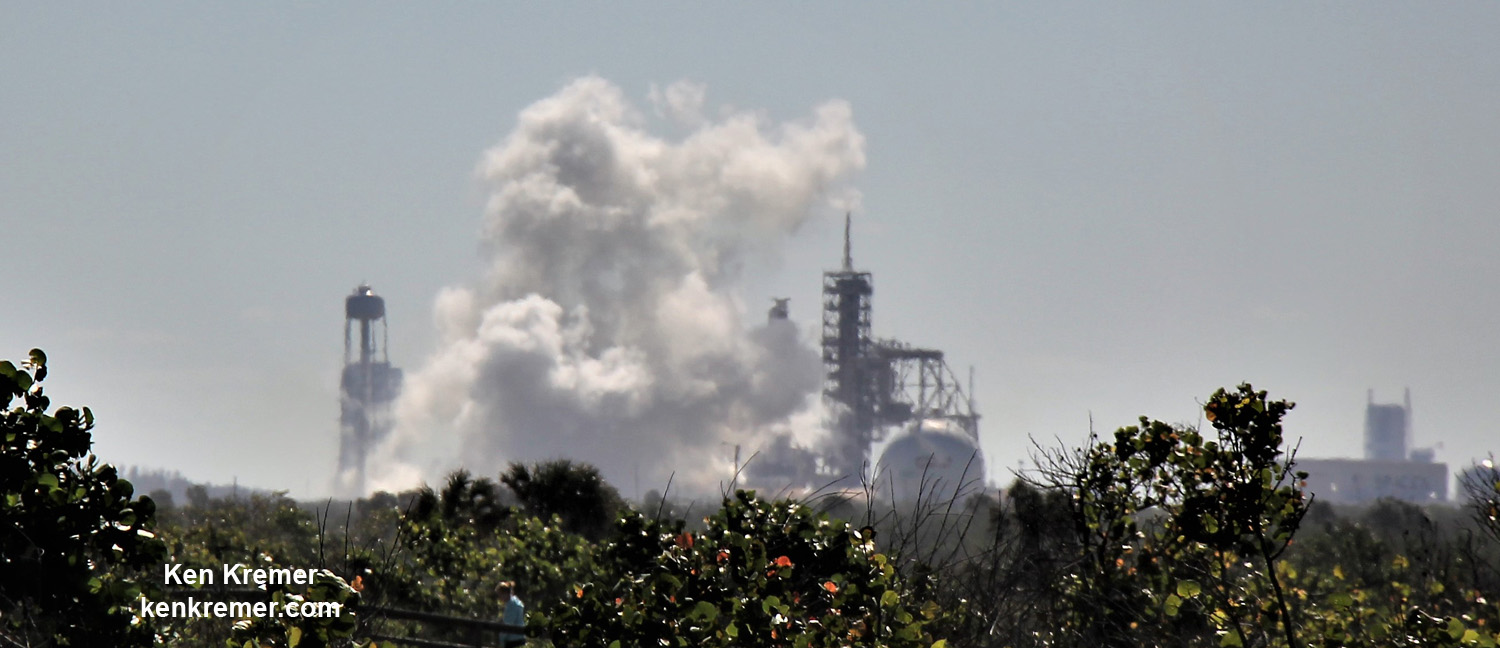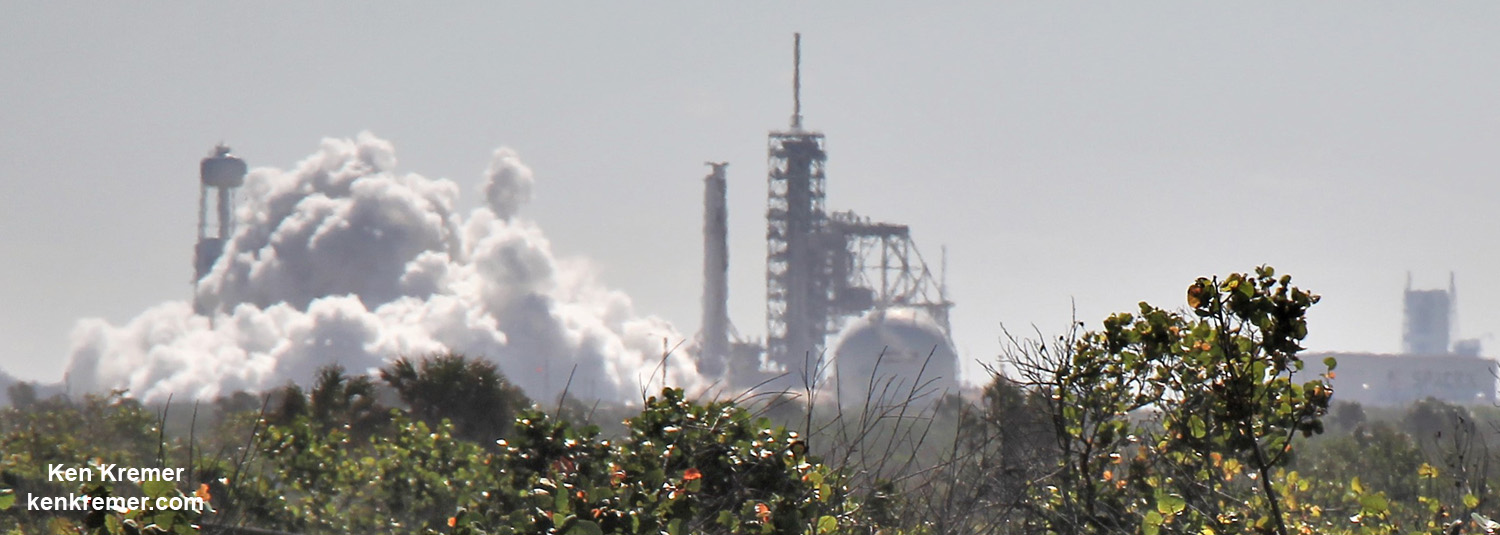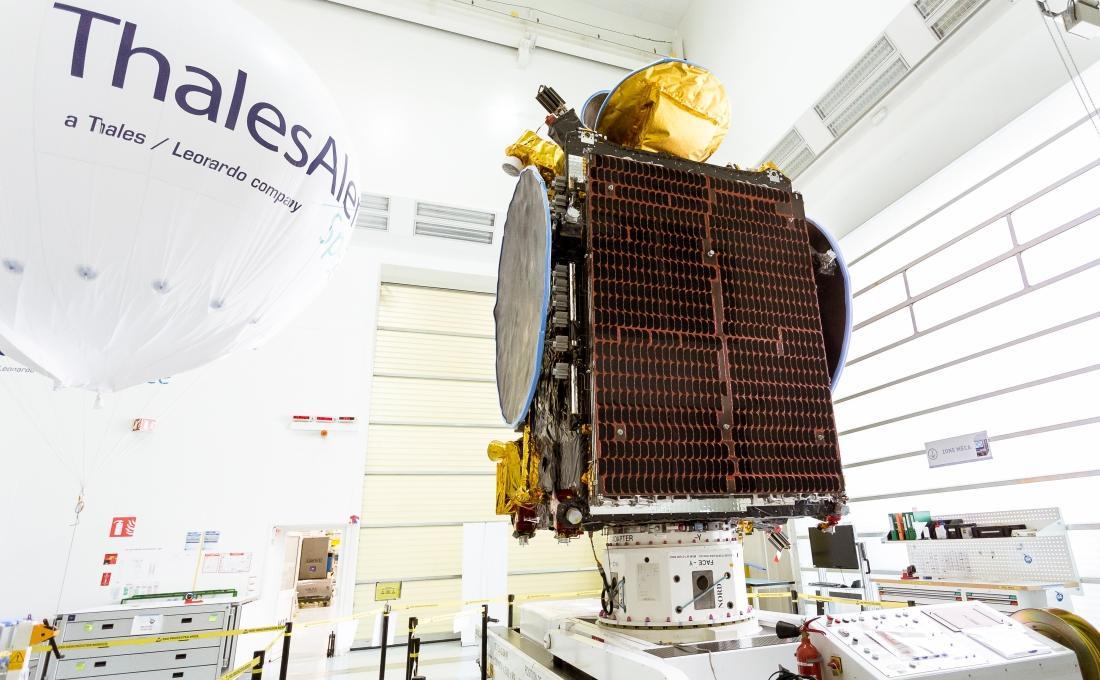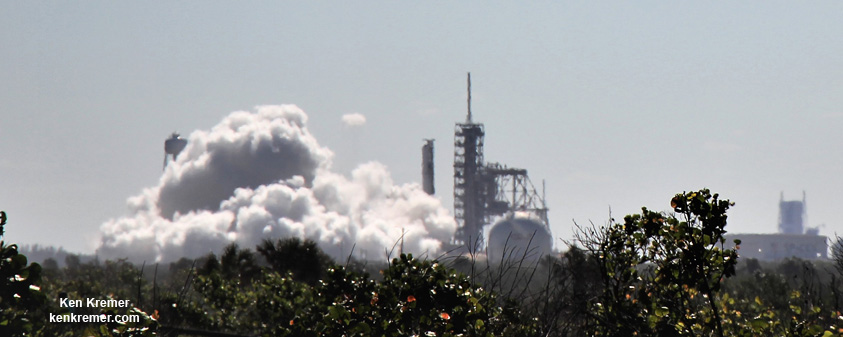
SpaceX conducts successful static hot fire test of never flown Falcon 9 booster atop Launch Complex 39A at the Kennedy Space Center on 26 Oct 2017 as seen from Playalinda Beach. Liftoff with KoreaSat-5A comsat is slated for 30 Oct 2017. Credit: Ken Kremer/Kenkremer.com
PLAYALINDA BEACH/KENNEDY SPACE CENTER, FL - The path to an October launch trifecta from Florida's Spaceport was cleared following SpaceX's successful static fire test of the Falcon 9 boosters first stage engines this afternoon, Oct. 26, and thereby targeting Monday, Oct. 30 for blastoff of the KoreaSat-5A commercial telecomsat.
KoreaSat-5A is being launched by SpaceX under a commercial contract for South Korean operator KTSAT (a KT Corporation company) using a new first stage.
If all goes well, the end of October KoreaSat-5A liftoff will count as the third rocket launch this month from the sunshine states increasingly busy Spaceport following two earlier launches carried out by both ULA and SpaceX.
Those two mid-month missions involved the commercial SES-11/EchoStar 105 UHDTV satellite on a SpaceX Falcon 9 and the covert NROL-52 spy satellite delivered to orbit on a ULA Atlas V respectively on Oct. 11 and Oct. 15.
The brief engine test of the two stage Falcon 9 took place at 12 noon EDT (1600 GMT) Thursday, Oct. 26, with the sudden eruption of smoke and ash rushing out the north facing flame trench and into the air over historic pad 39A on NASA's Kennedy Space Center during a very comfortably sunny and windy afternoon - as I witnessed from the crashing waves of Playalinda Beach, FL just a few miles away. See photo and video gallery from myself and space journalist colleague Jeff Seibert.
"Static fire test of Falcon 9 complete," SpaceX confirmed via tweet soon after the hotfire test was conducted.
"Targeting October 30 launch of Koreasat-5A from Pad 39A in Florida.
Monday's mid-afternoon liftoff with the private KoreaSat-5A mission is targeted for a window that opens at 3:34 p.m. EDT (1934 GMT) from seaside Launch Complex 39A at NASA's Kennedy Space Center in Florida.
The launch window for the virgin booster extends nearly two and a half hours until 5:58 p.m. EDT (2158 GMT).

SpaceX conducts successful static hot fire test of never flown Falcon 9 booster atop Launch Complex 39A at the Kennedy Space Center on 26 Oct 2017 as seen from Playalinda Beach. Liftoff with KoreaSat-5A comsat is slated for 30 Oct 2017. Credit: Ken Kremer/Kenkremer.com
The SpaceX Falcon 9 will deliver Koreasat-5A to a geostationary transfer orbit (GTO).
SpaceX will also attempt to recover this booster by soft landing on an ocean going platform prepositioned in the Atlantic Ocean - about 8 minutes after blastoff.
Playalinda Beach is a spectacular place to witness the launch from – while surfing the waves too - if you're in the area.
During today's hold down static fire test, the rocket's first and second stages are fueled with liquid oxygen and RP-1 propellants like an actual launch, and a simulated countdown is carried out to the point of a brief engine ignition.
The hold down engine test with the erected Falcon 9 rocket involved the ignition of all nine Merlin 1D first stage engines generating some 1.7 million pounds of thrust at pad 39A while the two stage rocket was restrained on the pad.
The static fire test lasted approximately three seconds. The test is routinely conducted by SpaceX engineers to confirm the rockets readiness to launch.
Watch this up close static hot fire test video:
Video Caption: SpaceX Falcon 9 Static Test Fire for Koreasat 5A / Oct 26, 2017. Credit: Jeff Seibert
In this case the SpaceX Falcon 9 will fly as a brand new rocket rather than a reused booster as happened earlier this month for the SES-11 launch.
The launch will be the 16th this year by a SpaceX Falcon 9 rocket.

KoreaSat-5A communications satellite in the Thales Alenia Space clean rooms. Credit: Thales Alenia Space
Koreasat-5A was built by prime contractor, Thales Alenia Space, responsible for the design, production, testing and ground delivery. It arrived at the Florida launch base on Oct. 5 for integration with the Falcon 9 rocket.
The 3,700 kg satellite is equipped with Ku-band transponders and based on Thales Alenia Space's new-generation Spacebus 4000B2 platform.
The solar panels provide a payload power of approximately 6.5 kW. It will ne positioned at 113° East and provide coverage for Indochina, Japan, Korea, the Philippines and the Middle East.
Pad 39A has been repurposed by SpaceX from its days as a NASA shuttle launch pad.

SpaceX conducts successful static hot fire test of never flown Falcon 9 booster atop Launch Complex 39A at the Kennedy Space Center on 26 Oct 2017 as seen from Playalinda Beach. Liftoff with KoreaSat-5A comsat is slated for 30 Oct 2017. Credit: Ken Kremer/Kenkremer.com
To date SpaceX has accomplished 18 successful landings of a recovered Falcon 9 first stage booster by land and by sea.
Watch for Ken's continuing onsite coverage of SpaceX KoreaSat-5A & SES-11, ULA NROL-52 and NASA and space mission reports direct from the Kennedy Space Center and Cape Canaveral Air Force Station, Florida.
Stay tuned here for Ken's continuing Earth and Planetary science and human spaceflight news.
Ken Kremer

SpaceX conducts successful static hot fire test of never flown Falcon 9 booster atop Launch Complex 39A at the Kennedy Space Center on 26 Oct 2017 as seen from Playalinda Beach. Liftoff with KoreaSat-5A comsat is slated for 30 Oct 2017. Credit: Ken Kremer/Kenkremer.com
No comments:
Post a Comment